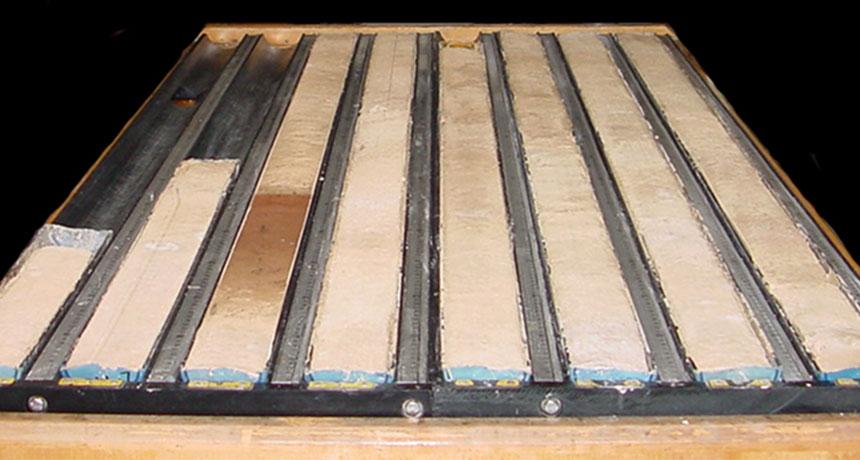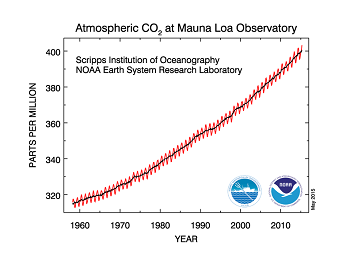Carbon dioxide levels rise fast and high
Human activities are prompting the greatest rate of increase since dinosaurs walked the Earth

Scientists measure carbon in sediment cores (seen here) drilled from the ocean floor. These cores show that extra carbon is being added to the atmosphere at a rate unmatched in 66 million years. Not even a massive outpouring of carbon 56 million years ago (the red band) comes close, a new study finds.
JAMES ZACHOS
MONTREAL, Canada — The buildup of carbon dioxide in Earth’s atmosphere just hit a new peak. The rate of rise in this greenhouse gas also constitutes a new record, with no sign of slowing. Scientists announced both new records on May 6.
In March, the average concentration in Earth’s atmosphere of carbon dioxide (CO2), reached a new high of 400 parts per million (ppm) in air. The National Oceanic and Atmospheric Administration (NOAA) reported this as the highest global level of this gas in the atmosphere since recordkeeping began in 1958.
But the new high shouldn’t be a surprise. Humans have been pumping CO2 into the atmosphere at a very high rate. Indeed, the current rate of increase is unmatched since the dinosaurs went extinct 66 million years ago. Scientists announced this new record, here, at a meeting of the American Geophysical Union and other organizations.
Coal, oil and other fossil fuels are the source of most of that extra CO2. People have been burning more of these fossil fuels steadily since 1750, which is when the Industrial Revolution began. And the rise in atmospheric CO2 has tracked that increase in fossil-fuel burning.

Previously, scientists had proposed that atmospheric levels of carbon had grown at a faster rate in prehistoric times. That was back some 56 million years ago. Volcanoes were among the likely sources at that time. Those prehistoric CO2 surges caused levels of the greenhouse gas in Earth’s atmosphere to hit a very high peak. But even then, it turns out, the carbon buildup in the air did not climb as rapidly as it is doing today.
Researchers have just learned this by comparing data collected from ocean-sediment cores with computer projections of climate. These comparisons showed that carbon levels in the atmosphere would have built up much more slowly in that distant past. Their best estimate is that levels, back then, would have grown at about one-tenth of the current rate.
If true, this would suggest that what is happening today has never happened before. It certainly appears true for our current era, the Cenozoic. This division of time began with the death of the dinosaurs.
The new finding also makes it harder to make predictions of what the future will be like, Richard Zeebe reports. As a paleoclimatologist, Zeebe studies climate over long periods in the prehistoric past. He works at the University of Hawaii at Manoa in Honolulu.
Climate experts want to know how our planet will respond as greenhouse gas levels continue to rise. But that’s hard to tell, as the current rate is so remarkable, he says. “Not a single event during the past 66 million years released carbon as fast as we’re releasing now,” he reported at the meeting.
Why scientists focus on this
To gauge what the future climate might look like, climate scientists study past events using computer models. Sometimes, these computer programs can’t accurately reproduce a historical event. When that happens, any future predictions based on that past event also may prove faulty. Meanwhile, increasing atmospheric CO2 levels are shifting today’s global climate. And many long-term impacts of these changes remain unknown.
That’s why scientists have been searching for a past event to use for a comparison.
One such event happened around 56 million years ago. Back then, global CO2 levels spiked. Levels in the atmosphere had been around 1,000 parts per million. Those levels rose to roughly 1,700 to 2,000 parts per million. The surge raised global temperatures. Understanding how long CO2 levels remained that high is key. It helps experts understand how fast carbon entered the atmosphere.
To track changes in the ancient air, scientists have been looking at ocean sediments. Over time, materials such as calcium carbonate rain down onto the ocean floor. Over time, these collect to create layers of sediments.
As atmospheric CO2 levels increase, the ocean becomes more acidic. The increased acidity dissolves more calcium carbonate. So scientists measure the amount of calcium carbonate in sediment. When levels of the carbonate fall, that can serve as a signal that atmospheric CO2 (and ocean acidity) has increased.
Not all of the CO2 in the atmosphere entered the air as that gas. Other carbon-bearing molecules such as methane can be released. Some come from sediments, for example. When methane reacts with oxygen in the air, it forms CO2 and water vapor. To account for such processes, scientists often focus not just on the release of CO2 from Earth’s surface, but also include measurements of other carbon sources. They track these together as “carbon releases.”
In 2013, researchers proposed that the event 56 million years ago released huge amounts of carbon in just over a decade. Some suggested a comet was to blame.
Zeebe and his colleagues doubted that the carbon release was that rapid. Using computer climate simulations, these experts first calculated the effects of releasing that much carbon over various amounts of time. Next, the experts compared the results with the ocean-sediment data. The simulations and sediment data agreed only when the carbon release took place over a period of more than 4,000 years, Zeebe points out.
If considered over that period, the yearly level of carbon releases would drop to roughly 1.1 billion metric tons. By comparison, burning fossil fuels now adds about 10 billion tons of carbon to the atmosphere each year.
What Zeebe’s group demonstrates is that people truly are “a geological force to be reckoned with,” says Gavin Schmidt. A climate scientist, he works at the NASA Goddard Institute for Space Studies in New York City.
Power Words
(for more about Power Words, click here)
atmosphere The envelope of gases surrounding Earth or another planet.
calcium carbonate The main chemical compound in limestone, a rock made from the tiny shells of ancient marine organisms. Its formula is CaCO3 (meaning it contains one calcium atom, one carbon atom and three oxygen atoms).
carbon The chemical element having the atomic number 6. It is the physical basis of all life on Earth. Carbon exists freely as graphite and diamond. It is an important part of coal, limestone and petroleum, and is capable of self-bonding, chemically, to form an enormous number of chemically, biologically and commercially important molecules.
carbon dioxide A colorless, odorless gas produced by all animals when the oxygen they inhale reacts with the carbon-rich foods that they’ve eaten. Carbon dioxide also is released when organic matter (including fossil fuels like oil or gas) is burned. Carbon dioxide acts as a greenhouse gas, trapping heat in Earth’s atmosphere. Plants convert carbon dioxide into oxygen during photosynthesis, the process they use to make their own food.
Cenozoic Era The most recent of the three major time period defining animal history. The Cenozoic spans roughly 65 million years, from the extinction of the non-avian dinosaurs.
climatology The study of weather conditions prevailing in an area in general or over a long period. Scientists who work in this field are called climatologists.
comet A celestial object consisting of a nucleus of ice and dust. When a comet passes near the sun, gas and dust vaporize off the comet’s surface, creating its trailing “tail.”
concentration A measurement of how much of one substance has been dissolved into another.
core In geology, Earth’s innermost layer. Or, a long, tube-like sample drilled down into ice, soil or rock. Cores allow scientists to examine layers of sediment, dissolved chemicals, rock and fossils to see how the environment at one location changed through hundreds to thousands of years or more.
dinosaur A term that means terrible lizard. These ancient reptiles lived from about 250 million years ago to roughly 65 million years ago. All descended from egg-laying reptiles known as archosaurs.
extinct An adjective that describes a species for which there are no living members.
fossil fuels Any fuel — such as coal, petroleum (crude oil) or natural gas — that has developed in the Earth over millions of years from the decayed remains of bacteria, plant or animals.
geology The study of Earth’s physical structure and substance, its history and the processes that act on it. People who work in this field are known as geologists. Planetary geology is the science of studying the same things about other planets.
geophysics The study of matter and energy on Earth and how they interact.
greenhouse gas A gas that contributes to the greenhouse effect by absorbing heat. Carbon dioxide is one example of a greenhouse gas.
Industrial Revolution A period of time beginning around 1750 that was marked by new manufacturing processes and a switch from wood to coal and other fossil fuels as a main source of energy.
National Oceanographic and Atmospheric Administration, or NOAA A science agency of the U.S. Department of Commerce. Initially established in 1807 under another name (The Survey of the Coast), this agency focuses on understanding and preserving ocean resources, including fisheries, protecting marine mammals (from seals to whales), studying the seafloor and probing the upper atmosphere.
paleo A prefix that means associated with ancient — especially geologically early — times.
parts per million (billion or trillion) Frequently abbreviated as ppm (or ppb or ppt), it is a measure of the number of units of some material that it mixed into another. The units should be the same (or equivalent) for both materials. The term is used to describing extremely small concentrations of one chemical dissolved in another. For example, a solution of 300 parts per billion of sodium in water would mean that there are 300 sodium atoms for every billion water molecules.
sediment Material (such as stones and sand) deposited by water, wind or glaciers.
simulate To deceive in some way by imitating the form or function of something. A simulated dietary fat, for instance, may deceive the mouth that it has tasted a real fat because it has the same feel on the tongue — without having any calories. A simulated sense of touch may fool the brain into thinking a finger has touched something even though a hand may no longer exists and has been replaced by a synthetic limb. (in computing) To try and imitate the conditions, functions or appearance of something. Computer programs that do this are referred to as simulations.
volcano A place on Earth’s crust that opens, allowing magma and gases to spew out from underground reservoirs of molten material.







